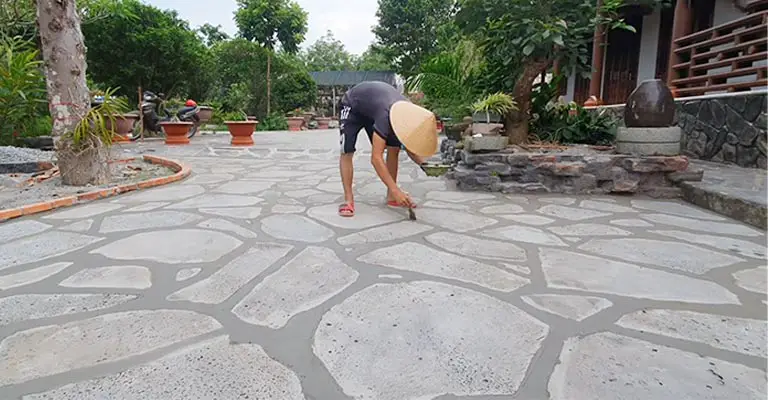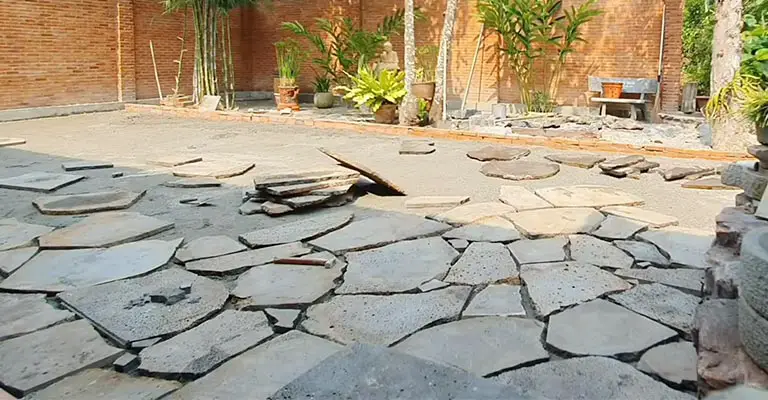No matter what your landscaping project is, such as digging up an old patio or completely landscaping your back yard, the question of what to do with old concrete slabs often arises and usually ends up with these slabs leaning against your fence or shed.
We can help you with old concrete slabs if you’re unsure what to do with them. The Internet has plenty of ideas for reusing slabs, such as making jigsaw-style paths from them, making makeshift plant pots from them, or even using them as BBQ borders (depending on their size).
First of all, if you are moving the slabs yourself, you must follow manual handling procedures and wear personal protective equipment like thick gloves and steel-toed boots.
Practical Ideas for Reusing Concrete Slabs
Old concrete slabs can be repurposed or disposed of in an environmentally responsible manner. Here are several options for what to do with old concrete slabs:
Reuse
If the concrete slabs are still in good condition, you can repurpose them for other projects.
For example, you can use them as a base for a new structure, such as a shed, deck, or patio. Alternatively, you can break them into smaller pieces and use them as stepping stones, garden borders, or even to create a decorative pathway.
Recycle
Concrete is a highly recyclable material. You can take the slabs to a recycling center or contact a concrete recycling company to process the material.
Recycled concrete can be crushed and used as aggregate for new concrete projects, road construction, or as a base for driveways.
Donation
If the slabs are still in good shape and you have no use for them, consider donating them to a local charity, community garden, or construction project. Many organizations and individuals may appreciate free or low-cost building materials.
Landfill or Disposal
If the concrete is in poor condition or cannot be reused or recycled, it may need to be disposed of in a landfill. Check with your local waste management authorities to ensure you follow the proper disposal procedures and regulations for your area.
Hauling Services
Some companies specialize in hauling away and disposing of concrete debris. They can break the concrete into smaller pieces on-site and then transport it to a recycling facility or landfill.
DIY Removal
If you have the equipment and are comfortable doing so, you can break up the concrete slabs yourself using a sledgehammer or a jackhammer.
Be sure to wear safety gear, and dispose of the broken concrete as recommended by your local authorities.
Artistic Projects
Some people use old concrete as a medium for artistic projects or sculptures. With creativity and some additional materials, you can transform old slabs into unique art pieces or functional objects.
Consult with a Professional
If you’re unsure about the condition of the concrete or how to handle its disposal, consider consulting with a professional contractor or concrete specialist. They can provide guidance on the best approach for your specific situation.
Before taking any action, it’s important to check local regulations and guidelines regarding the disposal of concrete waste, as rules may vary by location.
Additionally, consider the environmental impact of your choice and opt for recycling or reuse whenever possible to reduce waste and conserve resources.
DIY Concrete Makeover: Turning Old Slabs into Something New

It is inevitable that debris will accumulate at the end of any construction project. It could turn out that disposable materials can save you time and money in the long run.
In addition to being used as a subbase layer for other projects, leftover concrete can be a valuable resource.
Recycling concrete can cost up to $100 a ton, so reusing old slabs is not only a more environmentally friendly alternative, but can also help you save money.
There are only a few steps involved in turning old building materials into useful materials.
Things You’ll Need
- Plastic tarp
- 12 lbs. sledgehammer
- Electric jackhammer (optional)
- Pry bar or mattock
- Sand
- Gravel
- Chisel
- Hammer
- Power tamper
For a Path
Step 1
A plastic tarp should be placed over the concrete slab to avoid flying pieces. You will find it easier to handle smaller pieces of concrete if you break them up.
For slabs less than 4 inches thick, use a 12 lb sledgehammer. You will have an easier time, physically, if you rent an electric jackhammer for larger pieces. Pry bars or mattocks are useful tools for lifting and separating the pieces.
Step 2
Make your selection of stones. Reusing old concrete to lay a walking path in your yard or garden is a great way to recycle materials.
Make sure that the stones are the right size and arrange them in an interlocking pattern to ensure they fit. Additional chiseling may be necessary.
Step 3
Prepare the path by layering sand half an inch below the thickness of the stones and placing concrete pieces in a pattern.
In New Concrete Mix
Step 1
A concrete processing site should be able to handle the used concrete slabs.
Step 2
After removing contaminants such as steel and soil from concrete, workers pulverize and prepare it for concrete mixing by pulverizing it.
Step 3
If you’re mixing concrete for a project, you should include recycled concrete in the mix. A recycled concrete mix will require 15 percent more water than normal concrete because it absorbs more water than new concrete.
Tip
You should add a layer of gravel under the sand if your soil is prone to erosion. You can compact gravel with a power tamper. The amount of contaminants in RCA should never exceed 10 percent.
Reduce, Reuse, Recycle
To protect our environment, it’s important to reduce, reuse, and recycle as often as possible and observe the waste hierarchy.
If you live on a new build where everyone has the same garden fixtures, neighbors who are renovating their gardens might be able to take some of your slabs off your hands for you.
Nevertheless, it isn’t a reliable solution in this situation.
Some slabs might not be wanted by neighbors, leaving you to dispose of them yourself or transport them by yourself.
While moving them next door may not be a major hassle, if you have to move them to the end of the street, it will require a great deal of time and effort.
You can pass unwanted slabs on to friends and family on Facebook, Freecycle, and Gumtree, or even sell them to someone who might be able to use them.
Nevertheless, this option comes along with all of the risks and uncertainty of letting strangers into your home and in some cases, your internet account, so you should proceed with caution.
Final Words
We hope this information has shed light on the various options available for dealing with old concrete slabs.
Whether you choose to recycle, reuse, donate, or responsibly dispose of them, you’re taking a step towards both environmental sustainability and resourcefulness.







